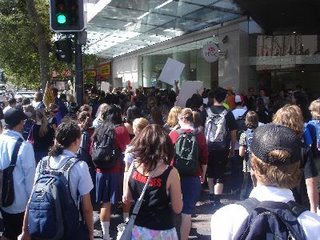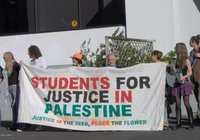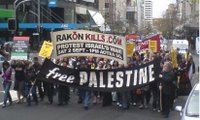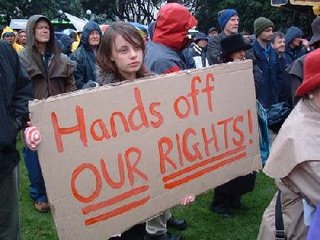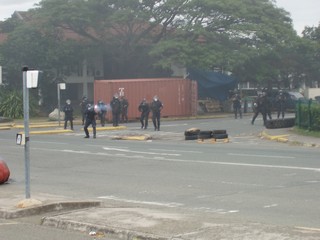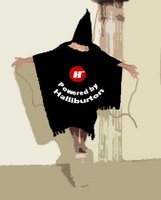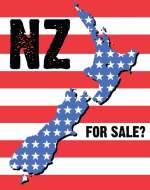A Radical Media for A Radical Movement - A Personal Account of the Aotearoa Indymedia Convergence
Friday
Around fifty-five people turned out to the evening of political documentaries that was the Antidote #15. Smush, premiered the first cut of his 30 minute documentary from Tonga which he peppered with his own insights from his experiences traveling around Tonga in the aftermath of the pro-democracy riots and subsequent repression. We also showed Whose News?, a 30 minute film produced by the Auckland Indymedia Collective in 2004 about the corporate media and the independent alternatives. However our feature was Tuhoe: History of Resistance, an hour long collection of footage and interviews from a people who have long had their views distorted, ignored and misrepresented in the corporate media. Meanwhile in Oamaru, as Indymedistas gathered APN owned Oamaru Mail broke the law and used scabs to undermine a workers strike.
Aperture, radio goon squads and Zorro? All at the AIMC Convergence
One of the most enlivening/exciting/good for something parts of the convergence was the hands-on workshops provided by people wit experience in their fields. Convergence attendees learnt why Aperture is critically important to taking good photos, how broadcasting on the wrong frequency can get you into trouble with the local Low Power FM posses, and that even if your dressed up as Zorro at an anti-GE protest, you still need an escape route when you decide to trespass on McDonalds property to get that beautiful Birds Eye View shot of the crowd coming up Queen Street.
“In March let’s all just drink lots of coffee, take party pills and stare at a screen for hours”
Funnily enough this seems to have been one of the best things to come from the conference. During Senchehes workshop on then state of the website, it was decided that we need more Indymedia folk to have tech skills so they can contribute to the maintenance of the indymedia website. From this was born, IndyGeek Boot Camp, a proposed weekend long intensive geek training school where revolutionary anti-capitalists go survivor style for 72 hours in Oblong (Wellington’s anarchist run infoshop/netcafe), to learn cool shit about software, programming, websites, etc. I think it is going to be March 9 to the 11. Better hurry and book a place now. We all know how popular this is going to be.
Another cool idea, I thought, is to display prominently on the site helpful “How to” guides to do with posting articles, writing html code, uploading video, photos, audio, editing the wiki and not turning indymedia into an uncritical PR site for big city, left wing activists.
Air, Moving and Still
Obviously the worst thing about the convergence for many people was the utter lack of air-conditioning in our relatively small and hugely sunny room with up to 25 bodies crammed inside. However one of the more productive outcomes is that Wellington Indymedia’s long running publication Windy will have it’s distribution, and coverage expanded to Auckland and hopefully around the country.
Even through the heat, people soldiered on and a reborn Auckland Collective has emerged that will look at setting up an Auckland Mult((i))media Group get more people excited about the potentials of multimedia technology, sharing their own stories and empowering their communities, the AMG was formed cause we needed a group that could act as a base in Auckland where people who want to change the world and also want to shoot video/make radio shows/take photos can come to and borrow technology, gain skills, and coordinate on projects.
Onwards and Upwards
Which is a suitably motivating title to remind you all to go and clean up the wiki and update the links section. Also maybe it will also inspire you to check out www.peace.fm or email Baraka, and find out about the fantastic Peace Not War project to use music, dance and creativity to support the liberal peace and green movements. It also is a good title to explain our decisions to remove the Full Copyright option from the options for contributors to our website (You can still, post articles, photo, video under a Creative Commons license). We’ve also now got the skills to push through the translation of Aotearoa Indymedia’s, base documents (Mission Statement, Points of Unity, Ed. Policy) into Te Reo Maori. And well also look into setting up a temporary Independent Media Center at the Umukai over Labour weekend, and supporting any efforts by South Island collectives to reform as part of the Aotearoa Indymedia network. And maybe, just maybe, the site will get a blogwire on the front page, able to syndicate the best of New Zealand’s left wing blog’s onto our site.
Thanks to:
Cooks and chopping helpers throughout the weekend
Dave B. for use of University space for the Antidote
Donators of money cause we came out of the Convergence with a net profit of $80
Freedom Shop folk who came and brought knowledge to the masses
Workshoppers who put in all the time and energy to prepare workshops and give them for nothing more than a free feed.
Unite for putting up with us on Saturday and Sunday
All those who attended cause without you it would have just been me and Strypey, wondering what we’d do with all the food we bought and what we’d say to all the workshopers we’d invited.
Plus, anyone, anywhere, who has ever had anything to do with Aotearoa Indymedia cause you are the folk that are the spirit of the movement for a free, for a democratic and for a revolutionary media that keep us all going.
P.S. See you all in Poneke/Wellington in early ’08 for the next one.
Labels: indymedia




